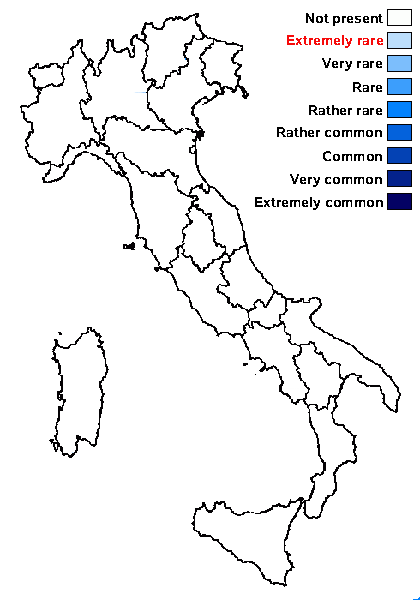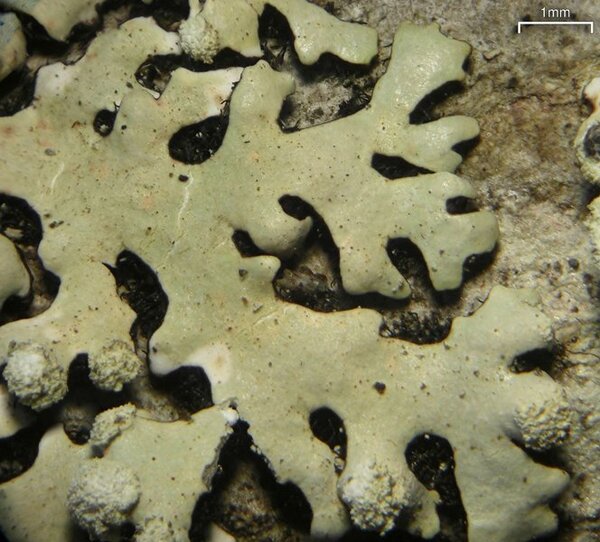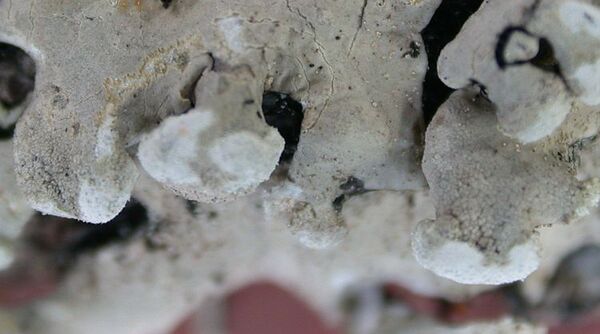Hypotrachyna pseudosinuosa (Asahina) Hale
Smithson. Contr. Bot., 25: 58, 1975. Basionym: Parmelia pseudosinuosa Asahina - J. Jap. Bot., 26: 329, 1951
Synonyms:
Distribution:
Description: Thallus foliose, heteromerous, dorsiventral, closely adnate, forming up to 5 cm wide, more or less regular rosettes, sorediate. Lobes 0.5-3 mm wide, usually separated in central parts but often slightly imbricate in marginal parts, dichotomously to irregularly branched, with rounded axils and slightly widened, more or less truncate tips. Upper surface very pale ash-grey (sometimes almost white) or glaucous grey, more or less distinctly white-maculate, with mainly subterminal (rarely laminal), capitiform soralia bearing farinose, whitish soredia. Lower surface black in central parts, brown in marginal parts, more or reticulately ridged, with slightly shiny, black to dark brown, more or less dichotomously branched rhizines, some of which may project beyond lobe margins. Upper cortex of tightly packed, anticlinally oriented hyphae, with a pored epicortex, the cell walls with isolichenan; medulla white, very rarely yellow-orange in lower part; algal layer continuous; lower cortex brown, of anticlinally oriented hyphae. Apothecia very rare, lecanorine, up to 2 mm across, with a brown disc and a sorediate thalline margin. Epithecium brownish; hymenium and hypothecium colourless. Asci 8-spored, clavate, Lecanora-type. Ascospores 1-celled, hyaline, ellipsoid, 9-13 x 6-9 µm. Photobiont chlorococcoid. Spot tests: upper cortex K+ yellow, C-, KC-, P- or P+ faintly yellow; medulla K- or K+ purple in the yellow-orange parts, C-, KC+ pink, P+ orange. Chemistry: upper cortex with atranorin; medulla with protocetraric acid, sometimes with anthraquinones.Note: a mainly epiphytic, tropical species also known from Western Europe; to be looked for in the most warm-humid parts of Tyrrhenian Italy.
Growth form: Foliose
Substrata: bark
Photobiont: green algae other than Trentepohlia
Reproductive strategy: mainly asexual, by soredia, or soredia-like structures (e.g. blastidia)
Most common in areas with a humid-warm climate (e.g. most of Tyrrenian Italy)

Predictive model
Growth form: Foliose
Substrata: bark
Photobiont: green algae other than Trentepohlia
Reproductive strategy: mainly asexual, by soredia, or soredia-like structures (e.g. blastidia)
Most common in areas with a humid-warm climate (e.g. most of Tyrrenian Italy)

Predictive model
 INDEX FUNGORUM
INDEX FUNGORUM
 GBIF
GBIF



